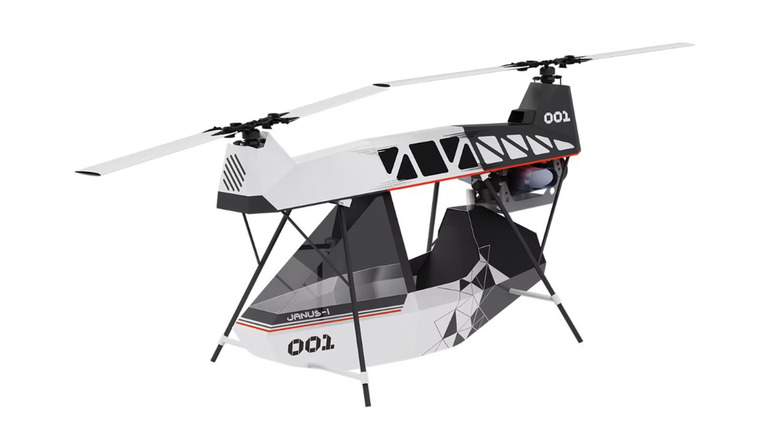This Fully-Functional VTOL Aircraft Can Fold Up To Fit In Your Trunk
The Janus-1 is a twin-rotor personal helicopter with the nickname of the flying suitcase. Developed by the Chinese company, X-Control, the nickname refers to the aircraft's diminutive size, and while it would be pushing it to actually squeeze the Janus-1 into a suitcase, it certainly folds down small enough to fit in a reasonably sized car trunk, boasting a transport volume of 124 gallons. Surprisingly in this day and age, X-Control didn't follow the electrical power route that competitors like Jetson and its sci-fi styled Jetson ONE took. Instead, the designers chose a turboshaft engine that can use diesel, kerosene, or Jet A fuel. With its twin blades, this configuration makes it reminiscent of a shrunken Chinook helicopter than an overgrown drone.
The Janus-1 weighs in at a mere 154 pounds and has a maximum takeoff weight of 595 pounds, giving a payload capacity of 441 pounds. Despite these modest dimensions, the Janus-1 is being marketed as more than just a novelty toy. It's a fully functional, multi-purpose VTOL aircraft that can take off and land from a space as small as just under 10 square feet, which is less than the area of an average parking lot.
The makers say that the machine is easy and intuitive to fly can be flown without a pilot's license. However, at least in certain configurations this may not be the case. For example, the makers claim the aircraft can be configured to carry two people which under FAA Part 103 rules disqualifies it as an ultralight aircraft, and therefore piloting it will require a license.
Janus-1: What we know
The Janus-1 is a modular-design (more about this later) VTOL aircraft that packs some serious engineering in its compact frame. It's built around a turboshaft engine that, when fully fueled, gives it a maximum flight time of around 40 minutes. The use of diesel is a departure from the preferred route of all-electric powertrains that are favored by many new VTOL concepts. The powertrain and the lightweight carbon fiber construction of the Janus-1 give it a cruising speed of 62 mph and a top speed just shy of 100 mph. The VTOL aircraft's twin-blade design provides lift without the need for a tail rotor (again, those comparisons with Boeing's Chinook are apparent), while its fly-by-wire control system reduces the need for complex mechanical linkages.
Now, if you're scared of heights, you may want to skip the next sentence. The Janus-1 — with its payload — has a maximum ceiling of 19,685 feet – time to get the winter-woolies out! Astonishingly, this is almost identical to the aforementioned H-47 Chinook, one of the most iconic military helicopters of all time.
The Janus-1 can also carry up to two people (within the 440-pound payload limit) or can be controlled remotely in unmanned operations, although for personal use the latter would certainly fall foul of current FAA drone regulations which restrict the size to 55 pounds.
Janus-1: A flying Swiss Army knife
X-Control has developed the Janus-1 to be more than just a personal transport vehicle. It's somewhat of a flying multi-tool, designed to be a customizable vehicle that can be reconfigured to suit a wide range of roles. The central core is key to this modular architecture. The core module can be adapted to fit a range of missions. The available adaptations allow the Janus-1 to be configured to act as a one or two-passenger craft, perform rescue operations, reconnaissance operations, and cargo delivery. It can also be fitted with floats to allow it to land and take off from water.
This capability could give the Janus-1 a broader appeal than many VTOL designs, which are often designed for one purpose and one market. While the usual flight time of 30 to 40 minutes may restrict its use, the makers also claim that this time can be increased to 8 hours. While there is no official confirmation as to how this is achieved, it's reasonable to assume that they haven't broken the laws of physics, and an auxiliary fuel tank or similar module is used to extend the range. It's also worth noting that a fuel capacity of more than five gallons also disqualifies this as an FAA classified ultralight.
The Janus-1 might not be an epic flying car, but this mini-helicopter does manage to squeeze a lot of technology and performance into something that can be transported in the trunk of an ordinary car.
